1. Shortest Cycle Time in this class
A standard cycle time of 0.45 sec. is achieved by drawing out the robot performance to its maximum level.
SCARA robot, the most distinctive feature of which is a completely beltless structure.
As the tip rotation axis is directly connected to the speed reduction gear, this achieves the overwhelming high-rigidity, high-speed, and high-accuracy.
This robot is used in a wide variety of processes and applications, such as production equipment for electrical and electronic components, and small precision machine components requiring the precise assembly, and assembly, handling, and transfer of large automotive components.

Orbit type YK350TW/YK500TW
1. Smaller equipment footprint – Layout design freedom
Featuring a ceiling-mount configuration with a wide arm rotation angle, the YK-TW can access any point within the full 1000 mm downward range. This eliminates all motion-related restrictions with regard to pallet and conveyor placement operations, while dramatically reducing the equipment footprint.
* Applies to the YK500TW
![[Orbit type SCARA robot][Standard type SCARA robot]](https://global.yamaha-motor.com/business/robot/lineup/ykxg/orbit/img/index/01_img1.gif)
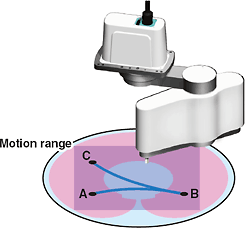
Optimize use of the space right below the main unit

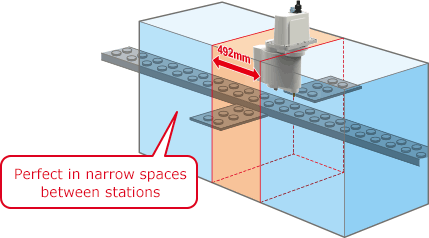
The standard cycle time for moving 1-kg load horizontally 300 mm and up/down 25 mm is shortened by approximately 36 % compared to existing YAMAHA models.

2. Higher quality assembly system. – Higher quality
This is a much higher repeated positioning accuracy than that offered by a parallel-link robot. This was accomplished by optimizing the robot’s weight balance through an extensive re-design of its internal construction. The lightweight yet highly rigid arm has also been fitted with optimally tuned motors to enable high accuracy positioning.
*Applies to the YK350TW
![[Hollow construction][Optimized rotation center of gravity moment]](https://global.yamaha-motor.com/business/robot/lineup/ykxg/orbit/img/index/02_img1.gif)
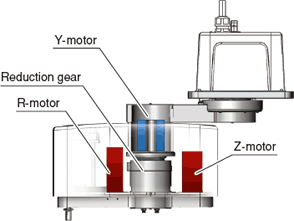
3. Reduces tact times – Higher productivity
The Y-axis (arm 2) passes beneath the X-axis (arm 1) and it has a horizontal articulated structure, allowing it to move along the optimal path between points. Moreover, the optimized weight balance of the internal components reduces the cycle time by 36 % as compared to previous models.
*Applies to the YK500TW

The standard cycle time for moving a 1-kg load horizontally 300 mm and up/down 25 mm is shortened by approx. 36 % compared to previous YAMAHA models.
4. Move heavy work pieces at high speeds – Suitable for a wide range of applications
Handles loads up to 5 kg. Also accommodates arm-end tools which tend to be heavy, making it highly adaptable to various applications.
5. Reduce height of equipment – Smaller equipment footprint
The YK-TW height is only 392 mm. This compact size enables more freedom in the equipment layout design.
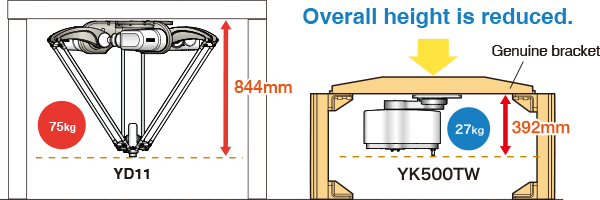
6. Parallel-link robots require large frames which complicate installation – Easy installation
* Applies to the YK500TW

An optional dedicated installation frame is available for the YK-TW. For details, contact a YAMAHA sales representative.
7. Preparing an installation stand is too much bother
As an option, we provide a dedicated installation stand for the YK-TW.*
There’s no need to calculate strength, so setup can be simplified.
*Contact us for details on dimensions and price
8. Operating our equipment in stringent environments is worrisome – Environment resistant
This resolver is a magnetic position sensor. It features a simple construction with no electronic or optical parts, making it far less susceptible to failure than conventional optical encoders. It is this superior environment resistance and low failure rate that makes it reliable enough for use in many fields such as hybrid automobiles and aircraft, etc., where reliability is essential.
Note1. In constant ambient temperature.
Note2. Tool flange specifications (optional) apply to the YK350TW (4kg) and the YK500TW (RCX340:4kg / RCX240:3kg)
Note3. When moving a 1kg load back and forth 30 mm horizontally and 25 mm vertically (rough positioning arch motion).
Note4. May need to limit parameters (such as acceleration) according to the moment of inertia being used.
* The recommended positional relationship regarding the center of the load weight (center of gravity position) and the offset amount from the R-axis center are shown in the graph below.


Only this robot has a completely beltless structure in its class. The robot is super-compact, but achieves the overwhelming high-rigidity and high-accuracy.
1. Internal structure achieving the high-rigidity and high-accuracy.
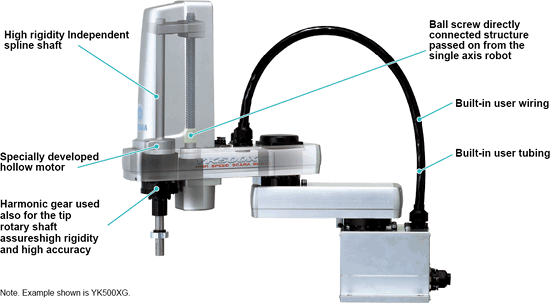
2. Completely beltless structure
A totally beltless structure was achieved by using a ZR axis direct coupling structure. This direct drive structure drastically reduces wasted motion. It also maintains high accuracy over a long period of time. It ensure maintenance-free usage for extended periods with no worries about belt breakage, stretching or deterioration with age (feature applies to all XG series models and the YK180X/YK220X).
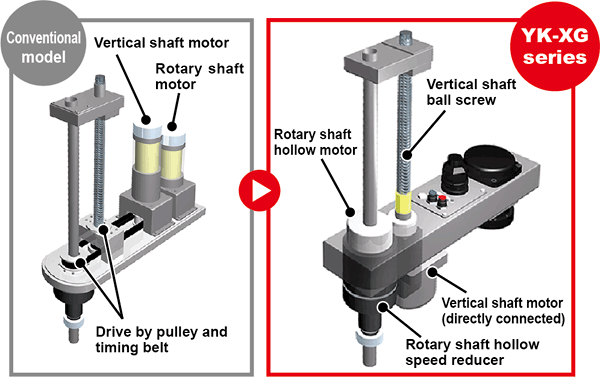
3. High speed
The standard cycle time is fast of course but the YAMAHA design also stresses tact time in the actual usage region. A drastic improvement in maximum speed was made by changing the gear ratio and maximum motor rpm. This also resulted in a better tact time during long distance movement.

4. Improved maintenance features
The covers on the YAMAHA SCARA robot YK-XG series can be removed from the front or upwards. The cover is separate from the cable so maintenance tasks are easy.
On ordinary robots replacing the grease on the harmonic gear takes a great deal of time and trouble because the gear must be disassembled and position deviations might occur. On YAMAHA SCARA robots however the harmonic gear is the grease-sealed type so no grease replacement is needed (YK-500XG to YK1000XG).
5. Robot R axis inertia moment capacity
SCARA robot performance is not limited to just standard cycle time. Actual work situations include a diverse range of heavy work pieces as well as work with large offsets. Using a low R axis inertia moment in those cases will help drastically cut the cycle time. All YAMAHA SCARA robots have a speed reducer directly coupled to the tip of the rotating axis. The R axis produces an extremely high allowable inertia moment which delivers high speed operation compared to structures where positioning is usually done by a belt after decelerating.
A large inertia is generated when the offset from the R axis to the load center is large and this can severely restrict the acceleration during operation.
The allowable inertia moment on the YAMAHA XG series is exceedingly large compared to other company SCARA robots in the same class and so can operate at high speed even with a work offset.
6. Compact
Changing the cable layout made the overall cable height lower than the unit cover.
Also, utilizing a motor with a small overall length and extrusion material base yielded the smallest dimensions among equipment in the same class.
7. Environmentally rugged resolver provides closed loop control
The position detector is a resolver. The resolver has a simple yet strong structure using not electronic components or elements and so has great features such as being extremely tough in harsh environments as well as a low breakdown rate. The resolver structure has none of the detection problems that occur in other detectors such as optical encoders whose electronic components breakdown or suffer from moisture or oil that sticks to the disk. Moreover, mechanical specifications for both absolute and incremental specifications are common to all controllers so one can switch to either absolute or incremental specifications just by setting a parameter.
Also even if the absolute battery is completely worn down, the SCARA can operate on incremental specifications so in the unlikely event of trouble one can feel secure knowing that there will be no need to stop the production line. The backup circuit has been completely renovated and now has a backup period extending to 1 year.
Note. The resolver has a simple structure not using electronic components at all. It is highly resistant to low and high temperatures, impacts, electrical noise, dust particles, oil, etc. and is used in automobiles, trains, and airplanes.
8. Zone control (=Automatically sets the maximum acceleration/deceleration) function
On SCARA robots there is a large difference in the load applied to the motor and the speed reducer depending on whether the robot arm is folded or extended. YAMAHA SCARA robots however can automatically set an optimal maximum acceleration and deceleration using the arm status when starting operation and the arm status when ending operation. This capability means that just entering the initial payload will prevent the robot from exceeding tolerance values for motor peak torque and speed reducer allowable peak torque. So full power can be extracted from the motor whenever needed and a high level of acceleration/deceleration maintained.
9. Hollow shaft and tool flange options are selectable
Useful options include a hollow shaft for easy wiring to the tip tool and a tool flange for tool clamping.
*YK250XG/YK350XG/YK400XG/YK500XGL/YK600XGL
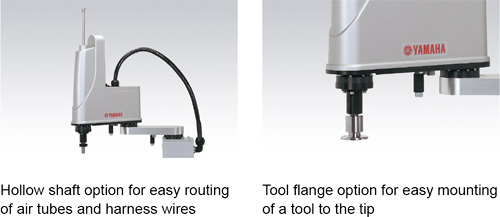
10. History of 30 years
The first YAMAHA robots were SCARA robots. Since the first SCARA robot called “CAME” was produced in 1979, some 30 years of SCARA robot innovations have continually appeared. These SCARA robots have undergone countless modifications in an everchanging marketplace and amassed a hefty record of successful products making them an essential part of the YAMAHA robot lineup.
| Model | Arm length (mm) | Maximum payload (kg) | Standard cycle time (sec) |
|---|---|---|---|
YK120XG | 120 | 1.0 | 0.33 |
YK150XG | 150 | ||
YK180XG | 180 | ||
YK180X | 180 | 0.39 | |
YK220X | 220 | 0.42 |

Suitable for assembly, transfer, pushing work, and sealing of small components.
1. Internal structure achieving the high-rigidity and high-accuracy.

2. Completely beltless structure
A totally beltless structure was achieved by using a ZR axis direct coupling structure. This direct drive structure drastically reduces wasted motion. It also maintains high accuracy over a long period of time. It ensure maintenance-free usage for extended periods with no worries about belt breakage, stretching or deterioration with age (feature applies to all XG series models and the YK180X/YK220X).

3. High speed
The standard cycle time is fast of course but the YAMAHA design also stresses tact time in the actual usage region. A drastic improvement in maximum speed was made by changing the gear ratio and maximum motor rpm. This also resulted in a better tact time during long distance movement.

4. Improved maintenance features
The covers on the YAMAHA SCARA robot YK-XG series can be removed from the front or upwards. The cover is separate from the cable so maintenance tasks are easy.
On ordinary robots replacing the grease on the harmonic gear takes a great deal of time and trouble because the gear must be disassembled and position deviations might occur. On YAMAHA SCARA robots however the harmonic gear is the grease-sealed type so no grease replacement is needed (YK-500XG to YK1000XG).
5. Robot R axis inertia moment capacity
SCARA robot performance is not limited to just standard cycle time. Actual work situations include a diverse range of heavy work pieces as well as work with large offsets. Using a low R axis inertia moment in those cases will help drastically cut the cycle time. All YAMAHA SCARA robots have a speed reducer directly coupled to the tip of the rotating axis. The R axis produces an extremely high allowable inertia moment which delivers high speed operation compared to structures where positioning is usually done by a belt after decelerating.
A large inertia is generated when the offset from the R axis to the load center is large and this can severely restrict the acceleration during operation.
The allowable inertia moment on the YAMAHA XG series is exceedingly large compared to other company SCARA robots in the same class and so can operate at high speed even with a work offset.
6. Compact
Changing the cable layout made the overall cable height lower than the unit cover.
Also, utilizing a motor with a small overall length and extrusion material base yielded the smallest dimensions among equipment in the same class.
7. Environmentally rugged resolver provides closed loop control
The position detector is a resolver. The resolver has a simple yet strong structure using not electronic components or elements and so has great features such as being extremely tough in harsh environments as well as a low breakdown rate. The resolver structure has none of the detection problems that occur in other detectors such as optical encoders whose electronic components breakdown or suffer from moisture or oil that sticks to the disk. Moreover, mechanical specifications for both absolute and incremental specifications are common to all controllers so one can switch to either absolute or incremental specifications just by setting a parameter.
Also even if the absolute battery is completely worn down, the SCARA can operate on incremental specifications so in the unlikely event of trouble one can feel secure knowing that there will be no need to stop the production line. The backup circuit has been completely renovated and now has a backup period extending to 1 year.
Note. The resolver has a simple structure not using electronic components at all. It is highly resistant to low and high temperatures, impacts, electrical noise, dust particles, oil, etc. and is used in automobiles, trains, and airplanes.
8. Zone control (=Automatically sets the maximum acceleration/deceleration) function
On SCARA robots there is a large difference in the load applied to the motor and the speed reducer depending on whether the robot arm is folded or extended. YAMAHA SCARA robots however can automatically set an optimal maximum acceleration and deceleration using the arm status when starting operation and the arm status when ending operation. This capability means that just entering the initial payload will prevent the robot from exceeding tolerance values for motor peak torque and speed reducer allowable peak torque. So full power can be extracted from the motor whenever needed and a high level of acceleration/deceleration maintained.
9. Hollow shaft and tool flange options are selectable
Useful options include a hollow shaft for easy wiring to the tip tool and a tool flange for tool clamping.
*YK250XG/YK350XG/YK400XG/YK500XGL/YK600XGL

10. History of 30 years
The first YAMAHA robots were SCARA robots. Since the first SCARA robot called “CAME” was produced in 1979, some 30 years of SCARA robot innovations have continually appeared. These SCARA robots have undergone countless modifications in an everchanging marketplace and amassed a hefty record of successful products making them an essential part of the YAMAHA robot lineup.
| Model | Arm length (mm) | Maximum payload (kg) | Standard cycle time (sec) |
|---|---|---|---|
| YK250XG | 250 | 5.0(4.0)Note | 0.49 |
| YK350XG | 350 | ||
| YK400XG | 400 | ||
| LOW COST HIGH PERFORMANCE SCARA ROBOT YK400XR | 400 | 3.0(2.0)Note | 0.45 |
Note. When an option (tool flange option or hollow spline shaft option for user wiring/tubing) is installed, the maximum payload is 4kg.

New SCARA robot YK400XR developed by redesigning evenmechanical components of conventional models. This SCARA robot gives the high quality and high performance,and yet superior cost performance.
1. Shortest Cycle Time in this class
A standard cycle time of 0.45 sec. is achieved by drawing out the robot performance to its maximum level.
2. Superior Cost Performance
Most economical price in YAMAHA’s similar robot class without sacrificing its existing features.
3. With Versatile and High Performance Controller RCX340
Combination of YK400XR robot and new RCX340 controller enable operation up to 16 axes with simple easy networking.
| YK400XR | X-axis | Y-axis | Z-axis | R-axis | |
| Axis specifications | Arm length (mm) | 225 | 175 | 150 | – |
|---|---|---|---|---|---|
| Rotation angle (°) | +/-132 | +/-150 | – | +/-360 | |
| AC servo motor output (W) | 200 | 100 | 100 | 100 | |
| RepeatabilityNote1(XYZ : mm)(R : °) | +/-0.01 | +/-0.01 | +/-0.01 | ||
| Maximum speed (XYZ : m/sec)(R : °/sec) | 6 | 1.1 | 2600 | ||
| Maximum payload(kg) | 3 (Standard specification), 2 (Option specificationsNote4) | ||||
| Standard cycle time: with 2kg payloadNote2(sec) | 0.45 | ||||
| R-axis tolerable moment of inertiaNote3(kgm2) | 0.05kgm2(0.5kgfcms2) | ||||
| User wiring (sq×wires) | 0.2 × 10 | ||||
| User tubing (Outer diameter) | φ4×3 | ||||
| Travel limit | 1.Soft limit 2.Mechanical stopper (X,Y,Z axis) | ||||
| Robot cable length (m) | Standard: 3.5 Option: 5,10 | ||||
| Weight (kg) | 17 | ||||
Note1. This is the value at a constant ambient temperature. (X,Y axes)
Note2. When reciprocating 300mm in horizontal and 25mm in vertical directions and performing the coarse positioning arch operation.
Note3. It is necessary to input the moment of inertia in the actual operating environment.
Note4. Maximum payload of option specifications (with user wiring/tubing through spline type) is 2kg.

Completely beltless structure with the tip rotation axis directly connected to the speed reduction gear.
This ensures high-accuracy, high-speed, excellent maintenance ability, and amazing tolerable moment of inertia.
1. Internal structure achieving the high-rigidity and high-accuracy.

2. Completely beltless structure
A totally beltless structure was achieved by using a ZR axis direct coupling structure. This direct drive structure drastically reduces wasted motion. It also maintains high accuracy over a long period of time. It ensure maintenance-free usage for extended periods with no worries about belt breakage, stretching or deterioration with age (feature applies to all XG series models and the YK180X/YK220X).

3. High speed
The standard cycle time is fast of course but the YAMAHA design also stresses tact time in the actual usage region. A drastic improvement in maximum speed was made by changing the gear ratio and maximum motor rpm. This also resulted in a better tact time during long distance movement.

4. Improved maintenance features
The covers on the YAMAHA SCARA robot YK-XG series can be removed from the front or upwards. The cover is separate from the cable so maintenance tasks are easy.
On ordinary robots replacing the grease on the harmonic gear takes a great deal of time and trouble because the gear must be disassembled and position deviations might occur. On YAMAHA SCARA robots however the harmonic gear is the grease-sealed type so no grease replacement is needed (YK-500XG to YK1000XG).
5. Robot R axis inertia moment capacity
SCARA robot performance is not limited to just standard cycle time. Actual work situations include a diverse range of heavy work pieces as well as work with large offsets. Using a low R axis inertia moment in those cases will help drastically cut the cycle time. All YAMAHA SCARA robots have a speed reducer directly coupled to the tip of the rotating axis. The R axis produces an extremely high allowable inertia moment which delivers high speed operation compared to structures where positioning is usually done by a belt after decelerating.
A large inertia is generated when the offset from the R axis to the load center is large and this can severely restrict the acceleration during operation.
The allowable inertia moment on the YAMAHA XG series is exceedingly large compared to other company SCARA robots in the same class and so can operate at high speed even with a work offset.
6. Compact
Changing the cable layout made the overall cable height lower than the unit cover.
Also, utilizing a motor with a small overall length and extrusion material base yielded the smallest dimensions among equipment in the same class.
7. Environmentally rugged resolver provides closed loop control
The position detector is a resolver. The resolver has a simple yet strong structure using not electronic components or elements and so has great features such as being extremely tough in harsh environments as well as a low breakdown rate. The resolver structure has none of the detection problems that occur in other detectors such as optical encoders whose electronic components breakdown or suffer from moisture or oil that sticks to the disk. Moreover, mechanical specifications for both absolute and incremental specifications are common to all controllers so one can switch to either absolute or incremental specifications just by setting a parameter.
Also even if the absolute battery is completely worn down, the SCARA can operate on incremental specifications so in the unlikely event of trouble one can feel secure knowing that there will be no need to stop the production line. The backup circuit has been completely renovated and now has a backup period extending to 1 year.
Note. The resolver has a simple structure not using electronic components at all. It is highly resistant to low and high temperatures, impacts, electrical noise, dust particles, oil, etc. and is used in automobiles, trains, and airplanes.
8. Zone control (=Automatically sets the maximum acceleration/deceleration) function
On SCARA robots there is a large difference in the load applied to the motor and the speed reducer depending on whether the robot arm is folded or extended. YAMAHA SCARA robots however can automatically set an optimal maximum acceleration and deceleration using the arm status when starting operation and the arm status when ending operation. This capability means that just entering the initial payload will prevent the robot from exceeding tolerance values for motor peak torque and speed reducer allowable peak torque. So full power can be extracted from the motor whenever needed and a high level of acceleration/deceleration maintained.
9. Hollow shaft and tool flange options are selectable
Useful options include a hollow shaft for easy wiring to the tip tool and a tool flange for tool clamping.
*YK250XG/YK350XG/YK400XG/YK500XGL/YK600XGL

10. History of 30 years
The first YAMAHA robots were SCARA robots. Since the first SCARA robot called “CAME” was produced in 1979, some 30 years of SCARA robot innovations have continually appeared. These SCARA robots have undergone countless modifications in an everchanging marketplace and amassed a hefty record of successful products making them an essential part of the YAMAHA robot lineup.
| Model | Arm length (mm) | Maximum payload (kg) | Standard cycle time (sec) |
|---|---|---|---|
| YK500XGL | 500 | 5.0(4.0)Note1 | 0.59 |
| YK500XG | 500 | 10.0(9.0)Note2 | 0.45 |
| YK600XGL | 600 | 5.0(9.0)Note2 | 0.63 |
| YK600XG | 600 | 10.0(4.0)Note1 | 0.46 |
| YK600XGH | 600 | 20.0(19.0)Note3 | 0.47 |
Note1. When an option (tool flange option or hollow spline shaft option for user wiring/tubing) is installed, the maximum payload is 4kg.
Note2. When an option (tool flange option) is installed, the maximum payload is 9kg.
Note3. When an option (tool flange option) is installed, the maximum payload is 19kg.

Suitable for assembly and transfer of large objects or heavy objects.
1. Internal structure achieving the high-rigidity and high-accuracy.

2. Completely beltless structure
A totally beltless structure was achieved by using a ZR axis direct coupling structure. This direct drive structure drastically reduces wasted motion. It also maintains high accuracy over a long period of time. It ensure maintenance-free usage for extended periods with no worries about belt breakage, stretching or deterioration with age (feature applies to all XG series models and the YK180X/YK220X).

3. High speed
The standard cycle time is fast of course but the YAMAHA design also stresses tact time in the actual usage region. A drastic improvement in maximum speed was made by changing the gear ratio and maximum motor rpm. This also resulted in a better tact time during long distance movement.

4. Improved maintenance features
The covers on the YAMAHA SCARA robot YK-XG series can be removed from the front or upwards. The cover is separate from the cable so maintenance tasks are easy.
On ordinary robots replacing the grease on the harmonic gear takes a great deal of time and trouble because the gear must be disassembled and position deviations might occur. On YAMAHA SCARA robots however the harmonic gear is the grease-sealed type so no grease replacement is needed (YK-500XG to YK1000XG).
5. Robot R axis inertia moment capacity
SCARA robot performance is not limited to just standard cycle time. Actual work situations include a diverse range of heavy work pieces as well as work with large offsets. Using a low R axis inertia moment in those cases will help drastically cut the cycle time. All YAMAHA SCARA robots have a speed reducer directly coupled to the tip of the rotating axis. The R axis produces an extremely high allowable inertia moment which delivers high speed operation compared to structures where positioning is usually done by a belt after decelerating.
A large inertia is generated when the offset from the R axis to the load center is large and this can severely restrict the acceleration during operation.
The allowable inertia moment on the YAMAHA XG series is exceedingly large compared to other company SCARA robots in the same class and so can operate at high speed even with a work offset.
6. Compact
Changing the cable layout made the overall cable height lower than the unit cover.
Also, utilizing a motor with a small overall length and extrusion material base yielded the smallest dimensions among equipment in the same class.
7. Environmentally rugged resolver provides closed loop control
The position detector is a resolver. The resolver has a simple yet strong structure using not electronic components or elements and so has great features such as being extremely tough in harsh environments as well as a low breakdown rate. The resolver structure has none of the detection problems that occur in other detectors such as optical encoders whose electronic components breakdown or suffer from moisture or oil that sticks to the disk. Moreover, mechanical specifications for both absolute and incremental specifications are common to all controllers so one can switch to either absolute or incremental specifications just by setting a parameter.
Also even if the absolute battery is completely worn down, the SCARA can operate on incremental specifications so in the unlikely event of trouble one can feel secure knowing that there will be no need to stop the production line. The backup circuit has been completely renovated and now has a backup period extending to 1 year.
Note. The resolver has a simple structure not using electronic components at all. It is highly resistant to low and high temperatures, impacts, electrical noise, dust particles, oil, etc. and is used in automobiles, trains, and airplanes.
8. Zone control (=Automatically sets the maximum acceleration/deceleration) function
On SCARA robots there is a large difference in the load applied to the motor and the speed reducer depending on whether the robot arm is folded or extended. YAMAHA SCARA robots however can automatically set an optimal maximum acceleration and deceleration using the arm status when starting operation and the arm status when ending operation. This capability means that just entering the initial payload will prevent the robot from exceeding tolerance values for motor peak torque and speed reducer allowable peak torque. So full power can be extracted from the motor whenever needed and a high level of acceleration/deceleration maintained.
9. Hollow shaft and tool flange options are selectable
Useful options include a hollow shaft for easy wiring to the tip tool and a tool flange for tool clamping.
*YK250XG/YK350XG/YK400XG/YK500XGL/YK600XGL

10. History of 30 years
The first YAMAHA robots were SCARA robots. Since the first SCARA robot called “CAME” was produced in 1979, some 30 years of SCARA robot innovations have continually appeared. These SCARA robots have undergone countless modifications in an everchanging marketplace and amassed a hefty record of successful products making them an essential part of the YAMAHA robot lineup.
| Model | Arm length(mm) | Maximum payload(kg) | Standard cycle time(sec) |
|---|---|---|---|
| YK700XGL | 700 | 10.0(Tool flange option 9.0) | 0.50 |
| YK700XG | 700 | 20.0(Tool flange option 19.0) | 0.42 |
| YK800XG | 800 | 0.48 | |
| YK900XG | 900 | 0.49 | |
| YK1000XG | 1000 | ||
| YK1200X | 1200 | 50.0 | 0.91 |

As the ceiling installation or the wall installation is used, the robot installation space that could not be used conventionally can be utilized efficiently.

1. Internal structure achieving the high-rigidity and high-accuracy.

2. Completely beltless structure
A totally beltless structure was achieved by using a ZR axis direct coupling structure. This direct drive structure drastically reduces wasted motion. It also maintains high accuracy over a long period of time. It ensure maintenance-free usage for extended periods with no worries about belt breakage, stretching or deterioration with age (feature applies to all XG series models and the YK180X/YK220X).

3. High speed
The standard cycle time is fast of course but the YAMAHA design also stresses tact time in the actual usage region. A drastic improvement in maximum speed was made by changing the gear ratio and maximum motor rpm. This also resulted in a better tact time during long distance movement.

4. Improved maintenance features
The covers on the YAMAHA SCARA robot YK-XG series can be removed from the front or upwards. The cover is separate from the cable so maintenance tasks are easy.
On ordinary robots replacing the grease on the harmonic gear takes a great deal of time and trouble because the gear must be disassembled and position deviations might occur. On YAMAHA SCARA robots however the harmonic gear is the grease-sealed type so no grease replacement is needed (YK-500XG to YK1000XG).
5. Robot R axis inertia moment capacity
SCARA robot performance is not limited to just standard cycle time. Actual work situations include a diverse range of heavy work pieces as well as work with large offsets. Using a low R axis inertia moment in those cases will help drastically cut the cycle time. All YAMAHA SCARA robots have a speed reducer directly coupled to the tip of the rotating axis. The R axis produces an extremely high allowable inertia moment which delivers high speed operation compared to structures where positioning is usually done by a belt after decelerating.
A large inertia is generated when the offset from the R axis to the load center is large and this can severely restrict the acceleration during operation.
The allowable inertia moment on the YAMAHA XG series is exceedingly large compared to other company SCARA robots in the same class and so can operate at high speed even with a work offset.
6. Compact
Changing the cable layout made the overall cable height lower than the unit cover.
Also, utilizing a motor with a small overall length and extrusion material base yielded the smallest dimensions among equipment in the same class.
7. Environmentally rugged resolver provides closed loop control
The position detector is a resolver. The resolver has a simple yet strong structure using not electronic components or elements and so has great features such as being extremely tough in harsh environments as well as a low breakdown rate. The resolver structure has none of the detection problems that occur in other detectors such as optical encoders whose electronic components breakdown or suffer from moisture or oil that sticks to the disk. Moreover, mechanical specifications for both absolute and incremental specifications are common to all controllers so one can switch to either absolute or incremental specifications just by setting a parameter.
Also even if the absolute battery is completely worn down, the SCARA can operate on incremental specifications so in the unlikely event of trouble one can feel secure knowing that there will be no need to stop the production line. The backup circuit has been completely renovated and now has a backup period extending to 1 year.
Note. The resolver has a simple structure not using electronic components at all. It is highly resistant to low and high temperatures, impacts, electrical noise, dust particles, oil, etc. and is used in automobiles, trains, and airplanes.
8. Zone control (=Automatically sets the maximum acceleration/deceleration) function
On SCARA robots there is a large difference in the load applied to the motor and the speed reducer depending on whether the robot arm is folded or extended. YAMAHA SCARA robots however can automatically set an optimal maximum acceleration and deceleration using the arm status when starting operation and the arm status when ending operation. This capability means that just entering the initial payload will prevent the robot from exceeding tolerance values for motor peak torque and speed reducer allowable peak torque. So full power can be extracted from the motor whenever needed and a high level of acceleration/deceleration maintained.
9. Hollow shaft and tool flange options are selectable
Useful options include a hollow shaft for easy wiring to the tip tool and a tool flange for tool clamping.
*YK250XG/YK350XG/YK400XG/YK500XGL/YK600XGL

| Model | Type | Arm length (mm) | Maximum payload (kg) | Standard cycle time (sec) |
|---|---|---|---|---|
| YK300XGS | Wall-mount | 300 | 5.0(4.0)Note1 | 0.49 |
| YK400XGS | 400 | |||
| YK500XGS | 500 | 10.0(9.0)Note2 | 0.45 | |
| YK600XGS | 600 | 0.46 | ||
| YK700XGS | 700 | 20.0(19.0)Note3 | 0.42 | |
| YK800XGS | 800 | 0.48 | ||
| YK900XGS | 900 | 0.49 | ||
| YK1000XGS | 1000 |
Note1. When an option (tool flange option or hollow spline shaft option for user wiring/tubing) is installed, the maximum payload is 4kg.
Note2. When an option (tool flange option) is installed, the maximum payload is 9kg.
Note3. When an option (tool flange option) is installed, the maximum payload is 19kg.

Can be used even in work environment where power dust flies or water splashes.
Equivalent to IP65


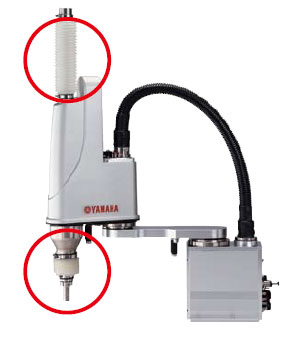
1. Internal structure achieving the high-rigidity and high-accuracy.

2. Completely beltless structure
A totally beltless structure was achieved by using a ZR axis direct coupling structure. This direct drive structure drastically reduces wasted motion. It also maintains high accuracy over a long period of time. It ensure maintenance-free usage for extended periods with no worries about belt breakage, stretching or deterioration with age (feature applies to all XG series models and the YK180X/YK220X).

3. High speed
The standard cycle time is fast of course but the YAMAHA design also stresses tact time in the actual usage region. A drastic improvement in maximum speed was made by changing the gear ratio and maximum motor rpm. This also resulted in a better tact time during long distance movement.

4. Improved maintenance features
The covers on the YAMAHA SCARA robot YK-XG series can be removed from the front or upwards. The cover is separate from the cable so maintenance tasks are easy.
On ordinary robots replacing the grease on the harmonic gear takes a great deal of time and trouble because the gear must be disassembled and position deviations might occur. On YAMAHA SCARA robots however the harmonic gear is the grease-sealed type so no grease replacement is needed (YK-500XG to YK1000XG).
5. Robot R axis inertia moment capacity
SCARA robot performance is not limited to just standard cycle time. Actual work situations include a diverse range of heavy work pieces as well as work with large offsets. Using a low R axis inertia moment in those cases will help drastically cut the cycle time. All YAMAHA SCARA robots have a speed reducer directly coupled to the tip of the rotating axis. The R axis produces an extremely high allowable inertia moment which delivers high speed operation compared to structures where positioning is usually done by a belt after decelerating.
A large inertia is generated when the offset from the R axis to the load center is large and this can severely restrict the acceleration during operation.
The allowable inertia moment on the YAMAHA XG series is exceedingly large compared to other company SCARA robots in the same class and so can operate at high speed even with a work offset.
6. Compact
Changing the cable layout made the overall cable height lower than the unit cover.
Also, utilizing a motor with a small overall length and extrusion material base yielded the smallest dimensions among equipment in the same class.
7. Environmentally rugged resolver provides closed loop control
The position detector is a resolver. The resolver has a simple yet strong structure using not electronic components or elements and so has great features such as being extremely tough in harsh environments as well as a low breakdown rate. The resolver structure has none of the detection problems that occur in other detectors such as optical encoders whose electronic components breakdown or suffer from moisture or oil that sticks to the disk. Moreover, mechanical specifications for both absolute and incremental specifications are common to all controllers so one can switch to either absolute or incremental specifications just by setting a parameter.
Also even if the absolute battery is completely worn down, the SCARA can operate on incremental specifications so in the unlikely event of trouble one can feel secure knowing that there will be no need to stop the production line. The backup circuit has been completely renovated and now has a backup period extending to 1 year.
Note. The resolver has a simple structure not using electronic components at all. It is highly resistant to low and high temperatures, impacts, electrical noise, dust particles, oil, etc. and is used in automobiles, trains, and airplanes.
8. Zone control (=Automatically sets the maximum acceleration/deceleration) function
On SCARA robots there is a large difference in the load applied to the motor and the speed reducer depending on whether the robot arm is folded or extended. YAMAHA SCARA robots however can automatically set an optimal maximum acceleration and deceleration using the arm status when starting operation and the arm status when ending operation. This capability means that just entering the initial payload will prevent the robot from exceeding tolerance values for motor peak torque and speed reducer allowable peak torque. So full power can be extracted from the motor whenever needed and a high level of acceleration/deceleration maintained.
9. Hollow shaft and tool flange options are selectable
Useful options include a hollow shaft for easy wiring to the tip tool and a tool flange for tool clamping.
*YK250XG/YK350XG/YK400XG/YK500XGL/YK600XGL

| Model | Arm length (mm) | Maximum payload (kg) | R-axis tolerable moment of inertia (kgm2) | Standard cycle time (sec) |
|---|---|---|---|---|
| YK250XGP | 250 | 4.0 | 0.05 | 0.49 |
| YK350XGP | 350 | 4.0 | 0.05 | 0.49 |
| YK400XGP | 400 | 4.0 | 0.05 | 0.49 |
| YK500XGLP | 500 | 4.0 | 0.05 | 0.59 |
| YK500XGP | 500 | 8.0 | 0.3 | 0.55 |
| YK600XGLP | 600 | 4.0 | 0.05 | 0.63 |
| YK600XGP | 600 | 8.0 | 0.3 | 0.56 |
| YK600XGHP | 600 | 18.0 | 1.0 | 0.57 |
| YK700XGP | 700 | 18.0 | 1.0 | 0.52 |
| YK800XGP | 800 | 18.0 | 1.0 | 0.58 |
| YK900XGP | 900 | 18.0 | 1.0 | 0.59 |
| YK1000XGP | 1000 | 18.0 | 1.0 | 0.59 |